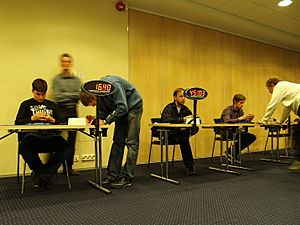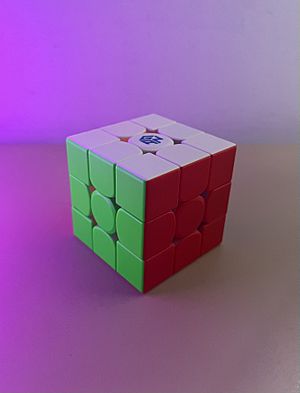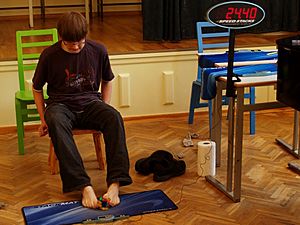Speedcubing facts for kids
Speedcubing is a fun sport where people solve different kinds of puzzles, like the famous 3x3x3 Rubik's Cube, as fast as they can! Someone who does this is called a speedcuber or just a cuber. To solve a puzzle, speedcubers use special moves called algorithms. These moves change a mixed-up puzzle into a solved one, where each side is a single, solid color.
The main group that organizes competitive speedcubing is the World Cube Association (WCA). They have 17 different events. These include solving cubes of different sizes (from 2x2x2 to 7x7x7), plus other puzzles like the Pyraminx, Megaminx, Skewb, Square-1, and Rubik's Clock. There are also special challenges like solving the 3x3x3, 4x4x4, and 5x5x5 puzzles while blindfolded, solving the 3x3x3 with one hand, finding the fewest moves to solve a 3x3x3, and solving many 3x3x3 puzzles while blindfolded.
As of July 2023, the fastest 3x3x3 solve ever in a competition was 3.13 seconds! This amazing record was set by Max Park. The record for the average of five solves (where the fastest and slowest times are removed) is 4.48 seconds, set by Yiheng Wang.
Contents
History of Speedcubing
The Rubik's Cube was created in 1974 by a Hungarian professor named Ernő Rubik. In 1979, the cube became super popular around the world. The first world championship for the Rubik's Cube happened on June 5, 1982, in Budapest, Hungary. Nineteen people competed, and an American named Minh Thai won with a time of 22.95 seconds. This was the fastest solve ever recorded in a competition at that time! Other important people there were Jessica Fridrich and Lars Petrus, who later helped create new ways to solve the cube.
After 1983, the Rubik's Cube became less popular. But then, the Internet came along! Websites started appearing where people could talk about the cube. These websites helped the cube become popular again, bringing in a new group of cubers who loved the sport.
People from the online community, like Ron van Bruchem and Tyson Mao, wanted to create places for cubers to meet and compete. In 2003, they organized a second world championship in Toronto, Canada. This led to many new competitions happening regularly. There were 12 competitions in 2004, and by 2018, there were over 1150! The World Cube Association (WCA) now organizes these events. Since the first championship in 1982, there have been nine more World Championships, usually held every two years. The most recent one was in Melbourne, Australia.
As speedcubing grew, many companies started making and selling their own speedcubes. They improved the cube's design to make it turn smoother and faster. This helped the Rubik's Cube become more than just a toy; it became a big business too!
How to Solve a Cube Fast
There are many ways to solve the standard 3x3x3 Rubik's Cube. Some methods are made for speedcubing, and some are not. The most popular and fastest methods are called the "Big 3": CFOP, Roux, and ZZ. Most speedcubers today use the CFOP method. The "Big 3" used to be the "Big 4" and included the Petrus method, but it's not as popular anymore. While some speedsolving methods use a layer-by-layer system with algorithms, others, like the Roux method, start by building a block on one side.
CFOP Method
The CFOP method is named after its four steps: Cross, F2L (First 2 Layers), OLL (Orientation of Last Layer), and PLL (Permutation of Last Layer). It's also known as the Fridrich method, named after Jessica Fridrich, who helped develop it. She finished second in the 2003 World Championships! The method was first published online in 1997 and helped bring back competitive speedcubing.
Here's how CFOP works:
- Cross: First, you solve a cross shape on one side of the cube.
- F2L: Then, you solve the first two layers together by pairing up corner and edge pieces.
- OLL: Next, you orient all the pieces on the last layer so they show a solid color on top. This uses a set of 57 algorithms.
- PLL: Finally, you move those pieces into their correct spots on the last layer. This uses a set of 21 algorithms.
For beginners, there's a simpler version of CFOP called the beginner's method or 4LLL (Four-Look Last Layer). It uses fewer algorithms (only 16 instead of 78) but is slower. Most fast speedcubers, like two-time World Champion Feliks Zemdegs and world record holder Max Park, use CFOP. They also learn extra algorithms to make their solves even faster!
Roux Method
The Roux method was created by a French speedcuber named Gilles Roux. Here are its steps:
- First, you build a 3x2x1 block, usually on the bottom left side.
- Second, you build another 3x2x1 block on the opposite side. This is called "block-building."
- Third, you solve the remaining four corner pieces using a set of algorithms called CMLL.
- Finally, you solve the last six edges (L6E or LSE).
The Roux method doesn't rely as much on memorizing algorithms as CFOP does. Most of the steps are done using your intuition. A cool thing about Roux is that you don't need to rotate the cube much, which helps you "look ahead" and plan your next moves. It's also very efficient, using about 45 to 50 moves for experienced solvers. However, it uses "M slice" moves (middle layer turns), which can be harder to do very quickly.
Some top cubers use Roux, like Kian Mansour, who broke the one-handed world record, and Sean Patrick Villanueva, who is one of the fastest Roux users in the world.
ZZ Method
The ZZ method was created by Zbigniew Zborowski in 2006. It's designed to help cubers turn the cube very fast. Here's how it works:
- The first step is called EOLine. You orient all the edge pieces and place two bottom edge pieces in their correct spots.
- Next, you solve the first two layers using only turns of the left, right, top, and bottom faces. This is a big advantage of ZZ!
- Because of EOLine, all the edges on the last layer are already oriented correctly. You can then finish the last layer using techniques from CFOP.
An advanced version of ZZ, called ZBLL, lets you solve the entire last layer in one step, but it requires learning 493 algorithms! ZZ uses fewer moves than CFOP (around 45-55 moves compared to CFOP's 55-60). However, EOLine can be tricky for some, which might make it harder to plan ahead and turn as fast as with CFOP.
Other Solving Methods
- Corners-first methods: These methods involve solving all the corner pieces first, then the edge pieces. They were popular in the 1980s, and the 1982 world champion, Minh Thai, used one. But today, speedsolvers rarely use them.
- Fewest Moves Challenge (FMC) methods: In this event, cubers try to solve the cube using the fewest possible moves. There isn't one standard method. Instead, competitors use different techniques like block-building (making small solved sections) and other clever tricks.
- Blindfolded methods: For blindfolded solving, cubers memorize the cube's state and then solve it without looking. Early methods used a "3-Cycle" approach. Today, faster methods like 3-Style and M2 are popular. Beginners often use the Old Pochmann Method, which solves one piece at a time. Blindfolded solvers use a special "lettering scheme" called Speffz to help them remember where each piece is. Each sticker on the cube is given a letter, and they use these letters to plan their moves.
Competitions
World Cube Association (WCA)
Speedcubing competitions have been held every year since 2003. The World Cube Association (WCA) was created in 2004 to manage all official competitions. For a competition to be official, it must be approved by the WCA and follow their rules. A WCA delegate must be there to make sure all the rules are followed. After the competition, the results are put on the WCA website. Judges watch the solves, delegates help the judges, runners bring the cubes to competitors, and scramblers mix up the cubes.
Competition Format
Most competitions use a "trimmed mean of five" format. This means a competitor does five solves. The fastest and slowest times are thrown out, and the average of the middle three solves is used as the final score. For bigger puzzles like the 6x6x6 and 7x7x7, they use the average of three solves. For blindfolded events or fewest moves challenges, they might use the average of three or just the best single solve.
When a round starts, competitors give their puzzles to the judges. The puzzles are mixed up using a computer-generated scramble. Each competitor in the round gets the same scrambles. Before starting, a competitor has up to 15 seconds to look at the puzzle (this is called inspection). A judge watches this time. When the solve is done, the judge writes down the time. If a puzzle isn't solved or the timer is stopped too early, the time is marked as "DNF" (Did Not Finish). There are also rules that can add two seconds to a solve time, like if a cube face is turned more than 45 degrees, or if a competitor takes too long to inspect.
The official timer used in competitions is the StackMat timer. It has touch-sensitive pads. You lift your hands to start the timer and place them back down to stop it after releasing the puzzle.
Official competitions have many different events:
| Event Type | Puzzles |
|---|---|
| Speedsolving | 2×2×2, 3×3×3, 4×4×4, 5×5×5, 6×6×6, 7×7×7 |
| Blindfolded Solving | 3x3x3, 4x4x4, 5x5x5, Multiple 3x3x3s |
| One-handed Solving | 3x3x3 |
| Solving in Fewest Moves | 3x3x3 |

Competitions also often include events for other puzzles, such as:
- Pyraminx: A pyramid-shaped puzzle.
- Megaminx: A twelve-sided puzzle similar to a 3x3x3.
- Skewb: A cube-shaped puzzle that became an official WCA event in 2014.
- Square-1: A cube puzzle that changes shape as you solve it.
- Rubik's Clock: A puzzle with clocks on both sides that you solve by setting all the clock hands to 12 o'clock.
- 3x3x3 with Feet: This event used to be official but was removed in 2020.
World Rubik's Cube Championships
The WCA holds the Rubik's Cube World Championship every two years. It's the biggest international competition. The last championship was in Melbourne, Australia, from July 11 to 14, 2019.
| Championship | Year | Host City | Winner (3x3) | Winning Time (Average) |
|---|---|---|---|---|
| I | 1982 | 22.95 (Single) | ||
| II | 2003 | 20.00 | ||
| III | 2005 | 15.10 | ||
| IV | 2007 | 12.46 | ||
| V | 2009 | 10.74 | ||
| VI | 2011 | 8.65 | ||
| VII | 2013 | 8.18 | ||
| VIII | 2015 | 7.56 | ||
| IX | 2017 | 6.85 | ||
| X | 2019 | 6.74 | ||
| XI | 2021 | Cancelled | — | |
| XII | 2023 | — | — |
World Records
Here are some of the official speedcubing world records approved by the WCA. Remember: For averages of 5 solves, the best and worst times are removed. For events with only 3 solves, the average of all 3 is taken.
| Event | Type | Result | Person | Competition (Date) |
|---|---|---|---|---|
| 3×3×3 | Single | 3.13 | Pride in Long Beach 2023 (June 11) | |
| Average | 4.48 | Mofunland Cruise Open 2023 (June 19-20) | ||
| 2×2×2 | Single | 0.47 | Northside Spring Saturday 2022 (November 26) | |
| Average | 1.01 | Pioneer Valley Cubing B 2023 (January 22) | ||
| 4×4×4 | Single | 16.79 | Bay Area Speedcubin' (April 3) | |
| Average | 19.38 | Arizona Speedcubing Spring 2023 (March 19) | ||
| 5×5×5 | Single | 32.88 | CubingUSA Nationals 2023 (July 27-30) | |
| Average | 36.46 | CubingUSA Western Championship 2023 (June 30-July 2) | ||
| 6×6×6 | Single | 59.74 | CubingUSA Southeast Championship 2022 (July 29-31) | |
| Average | 1:08.56 | WCC Western Championship 2022 (October 7-9) | ||
| 7×7×7 | Single | 1:35.68 | Marshall Cubing September 2022 (September 24) | |
| Average | 1:42.12 | Marshall Cubing September 2022 (September 24) | ||
| 3×3×3 Blindfolded | Single | 12.78 | 4BLD in a Madison Hall 2023 (January 28-29) | |
| Average | 14.72 | CubingUSA Mid-Atlantic Championship 2023 (June 17-19) | ||
| 3×3×3 Fewest Moves | Single | 16 | FMC 2019 (June 15–16) | |
| Average | 21.00 | North Star Cubing Challenge 2020 (January 18–19) | ||
| 3×3×3 One-handed | Single | 6.20 | Marshall Middle Slice 2022 (August 27) | |
| Average | 8.65 | Stevenage Spring 2022 (April 30-May 1) | ||
| Rubik's Clock | Single | 2.61 | CubingUSA Mid-Atlantic Championship 2023 (June 17-19) | |
| Average | 3.50 | CubingUSA Nationals 2023 (July 27-30) | ||
| Megaminx | Single | 24.44 | Di Tella Open v2 2023 (July 22-23) | |
| Average | 27.09 | Di Tella Open v2 2023 (July 22-23) | ||
| Pyraminx | Single | 0.75 | Berkeley Winter A 2023 (January 21) | |
| Average | 1.51 | Flag City Summer 2023 (July 22-23) | ||
| Skewb | Single | 0.81 | Rubik's WCA North American Championship 2022 (July 7-10) | |
| Average | 1.53 | Canadian Championship 2023 (July 13-16) | ||
| Square-1 | Single | 3.73 | CubingUSA Heartland Championship 2023 (June 2-4) | |
| Average | 4.91 | Stumptown Speedcubing Summer 2023 (July 22) | ||
| 4×4×4 Blindfolded | Single | 51.96 | 4BLD in a Madison Hall 2023 (January 28-29) | |
| Average | 1:08.76 | Michigan Cubing Club Epsilon 2019 (December 14) | ||
| 5×5×5 Blindfolded | Single | 2:19.07 | May MBLD Madness Singapore 2023 (May 20) | |
| Average | 2:27.63 | Michigan Cubing Club Epsilon 2019 (December 14) | ||
| 3×3×3 Multiple Blindfolded | Single | 62/65 | Blind Is Back LA 2022 (June 26) |
Lubrication
Speedcubers often put special lubricants on their cubes. This makes the cubes turn faster, smoother, and easier to control. The WCA allows lubrication in official competitions.
Most cube lubricants are made from silicone. This type of lubricant is safe and won't damage the cube. There are also water-based and plant-based lubricants, which can be fast but might dry out or spoil more quickly.
Images for kids
See also
 In Spanish: Speedcubing para niños
In Spanish: Speedcubing para niños




